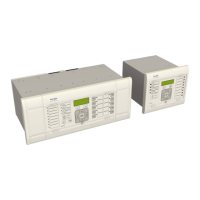2.5.2 Replacement of communications boards 374
2.5.3 Replacement of the input module 375
2.5.4 Replacement of the power supply board 376
2.5.5 Replacement of the I/O boards 376
2.6 Recalibration 376
2.7 Changing the battery 377
2.7.1 Post Modification Tests 377
2.7.2 Battery Disposal 377
2.8 Cleaning 377
3 Troubleshooting 378
3.1 Self-Diagnostic Software 378
3.2 Power-up Errors 378
3.3 Error Message or Code on Power-up 378
3.4 Out of Service LED on at power-up 379
3.5 Error Code during Operation 380
3.5.1 Backup Battery 380
3.6 Mal-operation during testing 380
3.6.1 Failure of Output Contacts 380
3.6.2 Failure of Opto-inputs 380
3.6.3 Incorrect Analogue Signals 381
3.7 PSL Editor Troubleshooting 381
3.7.1 Diagram Reconstruction 381
3.7.2 PSL Version Check 381
4 Repair and Modification Procedure 382
Chapter 16 Technical Specifications 383
1 Chapter Overview 385
2 Interfaces 386
2.1 Front Serial Port 386
2.2 Download/Monitor Port 386
2.3 Rear Serial Port 1 386
2.4 Fibre Rear Serial Port 1 386
2.5 Rear Serial Port 2 387
2.6 Redundant Ethernet Ports 387
2.7 IRIG-B (Demodulated) 387
2.8 IRIG-B (Modulated) 387
2.9 Rear Ethernet Port Copper 388
2.10 Rear Ethernet Port Fibre 388
2.10.1 100 Base FX Receiver Characteristics 388
2.10.2 100 Base FX Transmitter Characteristics 389
3 Busbar Protection Functions 390
3.1 Busbar Circuitry Fault Protection 390
3.2 Busbar Circuitry Fault Protection 390
3.3 Busbar Dead Zone Protection 390
3.4 Three-phase Overcurrent Protection 390
3.5 Earth Fault Protection 391
3.6 Transient Overreach and Overshoot 391
4 Performance of Monitoring and Control Functions 392
4.1 Voltage Transformer Supervision 392
4.2 PSL Timers 392
5 Measurements and Recording 393
5.1 General 393
5.2 Disturbance Records 393
5.3 Event, Fault and Maintenance Records 393
5.4 Fault Locator 393
6 Standards Compliance 394
MiCOM P747 Contents
P747-TM-EN-1 xi

